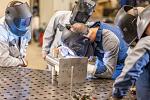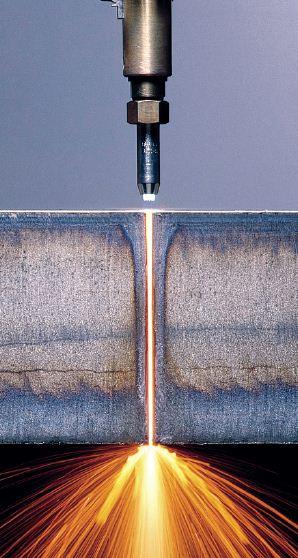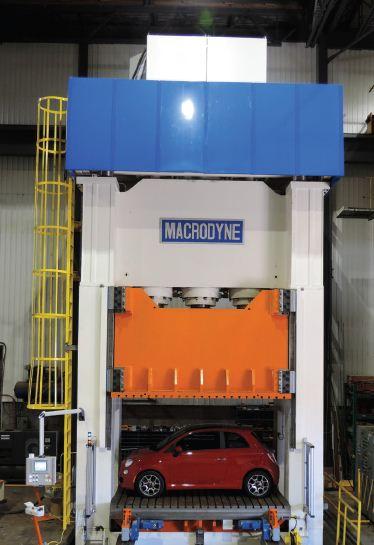Associate Editor
- FMA
- The Fabricator
- FABTECH
- Canadian Metalworking
The challenges of large part fabricating
Whether you are cutting, bending, stamping, or punching, there are a wide variety of solutions available to make it easier.
- By Lindsay Luminoso
- July 22, 2015
- Article
- Fabricating
Manufacturers of large parts face a different set of challenges than those shops working with smaller parts. For one thing, the decision to fabricate oversized materials comes with the economic challenge of purchasing a machine that accommodates parts that size. These machines require a significant footprint on the shop floor and demand additional handling accessories to efficiently move objects from one operation to the next. Automation and material handling systems are a great benefit when working with large parts.
“The biggest issues that customers face when processing large parts is real estate,” says Brad Williams, national sales manager for Koike. He explains that a typical 10- by 10-foot cutting machine installed properly with efficient safety zones can easily take up a 20- by 20-foot area. “When looking for equipment to cut large parts it’s important to make sure that the machine is built rugged enough to support all tools over a large working span. Is the rail system adequate to support the machine weight and keep it running true over the entire length of the rail system, and most importantly, does the manufacturer have a strong track record for building and supplying large format cutting systems?”
Another major factor when dealing with large part fabrication is operator efficiency and productivity, “especially when bending. As the operator becomes fatigued, there is a natural drop off in production,” says Brian Welz, product group manager for TRUMPF. Maximizing productivity is important for any shop, so finding solutions to deal with this common problem is important.
“Bending aids are an excellent feature to be added directly to the machine. Bending aids are designed to minimize the fatigue for the operator while a full automation solution like the BendMaster eliminates operator fatigue completely.”
There are many technical elements to consider when working with oversize sheets or plates. “It’s important to consider distortion and/or plate movement. When cutting large parts, especially multi-pass beveled parts, it’s critical to choose the right process and plan the cutting sequence.
“In tank and vessel manufacturing, for instance, having the ability to cut the long seams simultaneously can significantly increase production output and help keep distortion in check,” says Douglas Shuda, director of marketing, global cutting technologies for ESAB Welding & Cutting Products.
There is quite a difference fabricating a large part versus large sheets. Putting a large part on a large sheet is not a problem, according to Timothy Brady, punching and combi product manager for Amada America. “However, using “large sheets” to nest many smaller and/or medium size parts is a much more efficient use of the machine and can also result in much better utilization of material (i.e. less scrap), so this might be a factor that would push manufacturers to want to be able handle large sheets,” he explains.
What is considered a large part? This is very application specific but the experts agree; there is virtually no limit to a machine’s length capacity. Amada offers an automatic repositioning, which is “available to extend to maximum length (not width) of the sheet that can be processed. When using this feature, additional support tables must be added to the machines and additional clearances for the material movement to and from the machine may be required,” says Brady.
When it comes to width, the size of the machine generally dictates this feature. Experts all agree that the size restrictions are almost always predicated on the machine process (bending, stamping, cutting, etc.) as well as application.
For optimal results, large part fabricating demands that equipment and cutting processes be defined based on the application requirements, explains Shuda. Considerations such as plate size and material thickness are necessary to consider when exploring large part fabricating.
“Most machines are application specific as well; steel service centers, heavy equipment manufacturers, shipyards, railcar manufacturers and agricultural equipment manufacturers all typically look for large part capacity cutting systems,” says Williams.
One thing that is certain, job shops like flexibility. The ability to offer customers large part fabrication services can enahnce business. “[Shops] want to be able to support any job that comes their way and so large part fabrication is a part of this mix,” explains Welz. In addition to job shops, there are some industry specific needs. “In the Mid-West, for example, there tends to be more of the larger-format equipment. There are plenty of job shops, but also customers in or directly supporting the agriculture industry which tend to have larger parts. In Canada, the transportation industry also drives the need for larger format machines, especially where bus frames and similar products are manufactured.”
The machines themselves are not the only consideration when taking on the processing of oversize materials. Adding accessories and equipment to enhance large part fabricating can be just as important as choosing a quality machine. “The larger the part, the more difficult and time-consuming manual handling becomes, and the greater the safety risks as well,” says Tobias Reuther, product manager automation group for TRUMPF. Reuther explains that due to the part size, there are many cases in which two people are required to handle one part together. This drives up labor costs and reduces efficiency dramatically. Automation is one solution for this challenge.
Additional equipment and accessories may also need to be added to the shop floor in order to accommodate large raw material sheets, store finished products, and increase productivity. Brady states that forklifts would be a standard means of moving pallets of large (and small) material. However, if you are working with extremely large and heavy products, another option is an overhead crane system. “Overhead cranes are vital for moving large cut parts,” reiterates Williams. “Crane accessories include sling chains, magnets, plate clamps and vacuum lifting devices depending on the size, weight and material to be handled.”
There are some strong reasons for exploring the ability to process larger parts/sheets. “The added expense and square footage required by the larger machines can be a deterrent,” explains Brady. However, offering customers the ability to cut, bend, stamp, and fabricate a wide range of sizes and materials can provide a competitive advantage.
The availability of raw materials, the ability to store large sheets, material handling capabilities and general movement of large parts on the shop floor are all factors to consider when exploring large part fabricating.
There are a wide range of solutions available to make large part fabricating an efficient part of your portfolio.
About the Author

Lindsay Luminoso
1154 Warden Avenue
Toronto, M1R 0A1 Canada
Lindsay Luminoso, associate editor, contributes to both Canadian Metalworking and Canadian Fabricating & Welding. She worked as an associate editor/web editor, at Canadian Metalworking from 2014-2016 and was most recently an associate editor at Design Engineering.
Luminoso has a bachelor of arts from Carleton University, a bachelor of education from Ottawa University, and a graduate certificate in book, magazine, and digital publishing from Centennial College.
subscribe now


Keep up to date with the latest news, events, and technology for all things metal from our pair of monthly magazines written specifically for Canadian manufacturers!
Start Your Free Subscription- Trending Articles
Class is in session for college connections

BlueForge Alliance partners with Nuts, Bolts & Thingamajigs to develop Submarine Manufacturing Camps

Portable system becomes hot tech in heat treatment

Orbital tube welding webinar to be held April 23

Cidan Machinery Metal Expo 2024 to be held in Georgia May 1-2

- Industry Events
MME Winnipeg
- April 30, 2024
- Winnipeg, ON Canada
CTMA Economic Uncertainty: Helping You Navigate Windsor Seminar
- April 30, 2024
- Windsor, ON Canada
CTMA Economic Uncertainty: Helping You Navigate Kitchener Seminar
- May 2, 2024
- Kitchener, ON Canada
Automate 2024
- May 6 - 9, 2024
- Chicago, IL
ANCA Open House
- May 7 - 8, 2024
- Wixom, MI

















